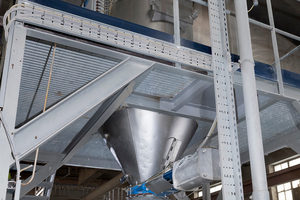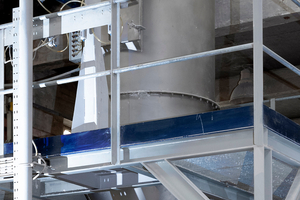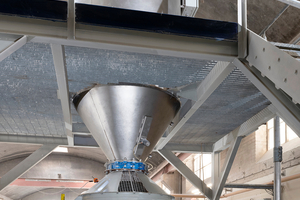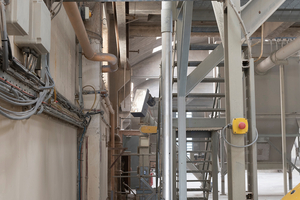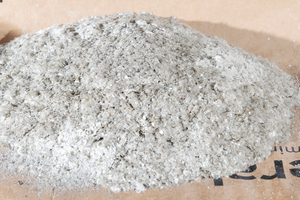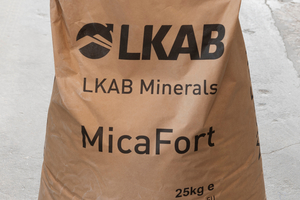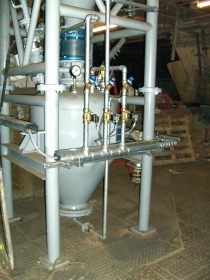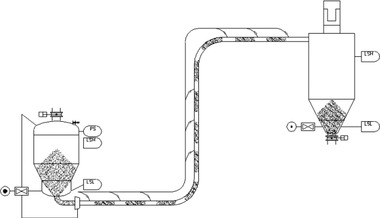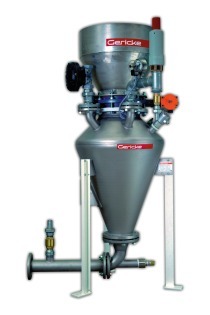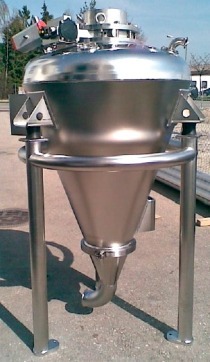Pneumatic conveying of wet, abrasive material
Processing muscovite
Mica received at the Derby Works as a fine powder in bulk bags undergoes one of six size reduction processes, depending on its end use. One of these is a wet process, in which water is added to create a hot, sand-like material with high moisture content ideal for use in paints and coatings.
The material was originally transported to a drying system on the floor above using a forklift and bucket elevator, and subsequently by a mechanical conveyor and bucket elevator to distance workers from the material. However, components of both systems suffered abrasive wear.
Most alternate equipment evaluated either could not be routed as needed, move the moist material efficiently and/or resist abrasive wear. “We looked at a number of conveying systems, but most suppliers considered the material and the restricted routing as too much of a challenge. Ultimately, only Flexicon was willing to take on the project and offer a viable solution,” says Samantha Bucknall, UK Group Performance Manager at LKAB.
Pneumatic conveying
“It was a new material for them,” continues Bucknall. “We supplied a batch to the company’s test lab and worked with them to find the best solution.” The resulting automated system is comprised of a 560 l capacity floor hopper, which receives the mica from the wet process via mechanical conveyor. Pneumatic rather than mechanical conveying permitted the most direct material transfer path. A 30 m long, 75 mm diameter PNEUMATI-CON® vacuum line propels the muscovite vertically 11 m to the floor above and around two 90° bends to a 1220 mm diameter filter receiver. The filter receiver separates the muscovite from the conveying air and is sized to hold 800 l of material.
The dilute phase vacuum system is powered by a 15 kW positive displacement vacuum pump, at 500 mbar pressure differential. The filter receiver is sized to hold an entire wet mill batch, and includes a level sensor to signal the PLC when the full batch is accumulated and the next batch should be fed to the mill.
The filter receiver includes an automatic reverse-pulse jet cleaning system, which dislodges material accumulated on the filter elements to maintain optimal conveying performance, and returns it to the batch to eliminate waste. Bag filters were selected over cartridge filters for more effective release of the sticky material.
Material is then transferred from the filter receiver to a drying system, then to any of three sieving stations for separating the product in two particle sizes. Due to greater customer demand for finer mica, two of the three sieving stations produce a 90 µm particle size, while the third produces a coarser 125 µm particle size.
LKAB supplies Mica under the trade name MicaFort in 25 kg bags, 1 t bulk bags, or in bulk tankers.
Overcoming conveying challenges
Installation of the new pneumatic system was difficult as it is located in a very tight space,” continues Bucknall. “We experienced a number of challenges during early operations, but Flexicon stayed with us to find solutions as these arose.” One challenge stemmed from mica’s abrasiveness, which ate through one of the elbows within six weeks of operation. “Flexicon suggested we replace the worn bend with a SMART ELBOW® deflection elbow from HammerTek Corporation. This gave us 12 months of operation, almost nine times longer,” says Bucknall.
The deflection elbows are designed to minimize wear of the elbow wall. Unlike conventional elbows, which rely on material impact to change direction of material flow, the deflection elbow features a spherical chamber that protrudes just beyond the pathway of the material. A ball of suspended material rotates in the chamber, gently deflecting incoming material around the bend and preventing it from impacting the elbow wall.
Overall the project represented a “leap of faith for us as we had not used a pneumatic transfer before and we were not sure how it would handle the wet mica,” concludes Bucknall. “We overcame obstacles and now have a system that performs well and are more than happy with the service provided.”

